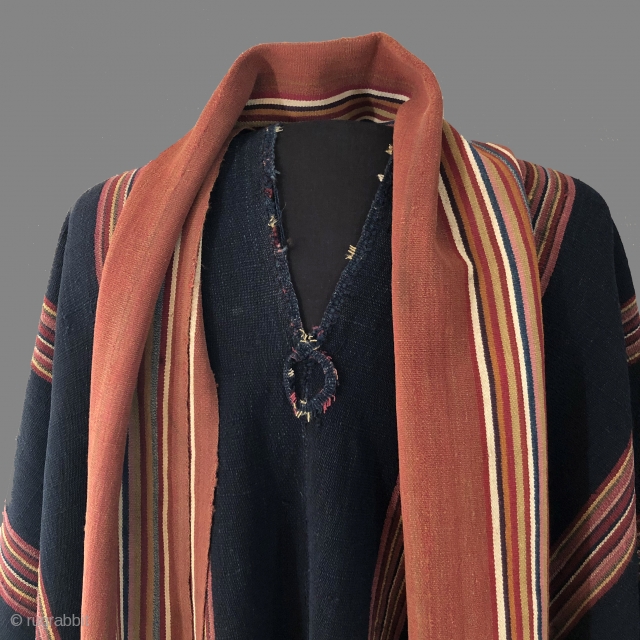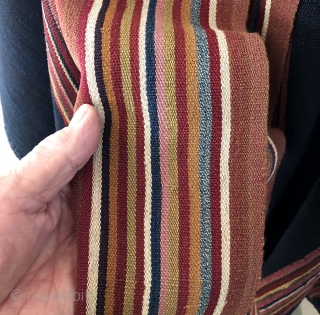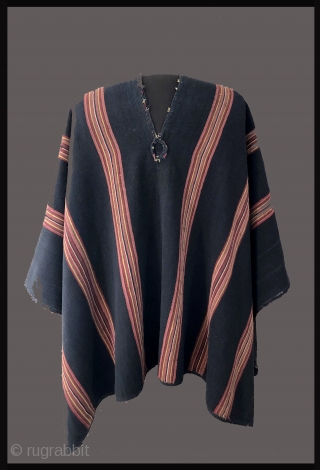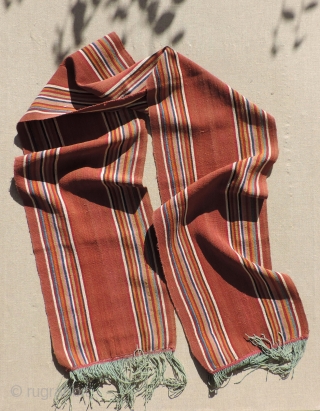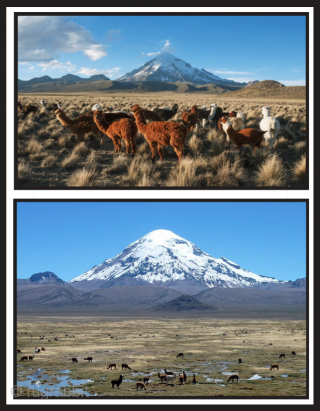Back
Aymara chieftain's ceremonial attire. Bolivian altiplano. 19th century. This arrangement of Aymara warp faced textile garments would be worn by a hereditary leader for ceremonial occasions and would signal his importance within the community. Shown here are a deep indigo dyed blue striped poncho topped by a very fine scarf-like shoulder mantle. The exceptional color, fineness of weave and spinning of the shoulder mantle gives a drape and elegance to the cloth that is impressive. These factors combine to make this garment exceptional and reflect the virtuosity of the more than two thousand year old textile tradition among the indigenous Aymara. Nowhere else in the world are finer warp-faced textiles produced in wool fiber. It was woven from exceptionally finely spun two ply alpaca yarns - many of which were made by spinning two different colored yarns together. When grouped together as in the ground of this textile, a unique color field is the result. This use of two ply, bi-chrome yarns is unique to Aymara textiles and is called 'chimi' in Aymara. The owner of such a garment would be referred to as a 'Hattatatta' or very important man. Textiles like this are quite rare and when found, usually have fine cloth and great color. Even so, this piece is at the top of its class. These long narrow textiles were worn folded lengthwise and draped over the shoulders almost like a priest's vestment and could be wrapped around the neck for warmth if needed. These were not every day items, but were reserved for important occasions and passed down through generations. a textile of this quality would be highly revered and treasured by the family to which it belonged. The scarf is 12 x 90 inches with fringes. Available separately or with the poncho if desired. Brighter images shot outdoors in direct sunlight.
price:
BOTH SOLD THANK YOU
- Home
- Antique Rugs by Region
- Category
- Profiles
- Post Items Free
- Albums
- Benaki Museum of Islamic Art
- Budapest: Ottoman Carpets
- Gulbenkian Museum
- Islamic Carpets. Brooklyn
- Islamic Textiles. Brooklyn
- Konya Museum: Rugs
- MKG, Hamburg
- MMA: Caucasian Carpets
- MMA: Mamluk Carpets
- MMA: Mughal Indian Carpets
- MMA: Ottoman Carpets
- MMA: Safavid Persian Carpets
- MMA: Turkmen Rugs
- McCoy Jones Kilims
- Ottoman textiles. Met
- Philadelphia Museum
- Rugs and Carpets: Berlin
- Seljuqs at the Met
- TIEM, Istanbul: Carpets
- V&A: Classical Carpets
- Vakiflar Carpets: Istanbul
- Baluch Rugs: Indianapolis
- Gallery Exhibitions
- Jaf an Exhibition
- Alberto Levi Gallery
- Andean Textile
- Christie's London: 2016
- Francesca Galloway
- HALI at 40
- ICOC Washington, DC 2018
- Jajims of the Shahsavan
- London Islamic Week April, 2018
- Mongolian Felts
- Navajo Rugs: JB Moore
- Persian Piled Weavings
- SF Tribal & Textile Art Show 2020
- SF Tribal 2019
- Sotheby's: C. Alexander
- Turkish Prayer Rugs
- Turkmen Main Carpets ICOC 2007








